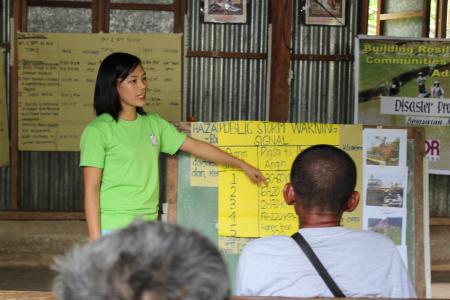“It is the first time that training like this has been conducted in our place. Most training were conducted in the town proper (Poblacion) so we are very thankful you came” said Mr. Felix Cadangan, the chairman of the Binasaran Farmers and Community Organization (BFCO). He was referring to the Disaster Preparedness Training conducted by the Cordillera Disaster Response and Development Services Inc. (CorDisRDS Inc.) on September 24 – 25, 2016 at Barangay Binasaran, Malibcong, Abra. There were 26 community members composed of representatives from the elderly, youth, men, women and the local barangay council who participated in the training.
The participants were given inputs on community-based early warning systems, evacuation planning and evacuation center management, tasks and responsibilities of the local disaster management structure and other skills on disaster management. Participants conducted workshops to update the results of the community risk assessment, developed their own early warning system and evacuation plan for them to be better prepared during disasters.
One of the highlight of the discussions was whether the funds allotted for emergency response would be sufficient to provide for the needs of the community members affected by disasters. Also, through the discussions, the participants realized that their Barangay Disaster Risk Reduction and Management Committee (BDRRMC) is not yet fully functional. There were also discussions and questions regarding the utilization of the five percent Local Disaster Risk Reduction and Management Fund (LDRRMF) such as whether said fund could be used for other community development projects.
During the training, the participants also shared their local indigenous early warning systems, an example is the movement of snails from the river to higher ground signifies the onset of a flood or rise of water level in the river. They also shared their traditional methods of disaster preparedness such as collective labor to put support for houses with weak foundation, transferring of livestock to safe areas, removal or diverting flow of water in their irrigation canals to prevent flooding of rice fields and pruning of banana leaves to prevent the trees from being uprooted.
The outputs of the activity were the completion of the evacuation plan of Sitio Binasaran Proper and the development of a community-based early warning system that utilizes the church bell to alert the community in case there is a need for evacuation. The Disaster Preparedness Committee (DPC) also reviewed their tasks and responsibilities . The Damages, Need, Capacities Assessment (DNCA) tool was introduced to the participants in order to facilitate proper data gathering on effects of disasters and help identify appropriate response interventions by the government and other assisting agencies.
According to the participants, the training was very helpful for the whole community. They mentioned that they gained additional knowledge on the disasters they face, the tasks and responsibilities of the BDDRMC & DPC, the importance of having an evacuation plan and early warning system. They became aware of the existence of the Philippine Disaster Risk Reduction and Management Act (RA 10121) mandating the government to protect the lives of its citizens before and during disasters. They also understood the importance of disaster preparedness especially in a remote community like theirs with insufficient basic social services from the government.
Overall, they said that working together is important in protecting their natural resources for them to be better prepared for any upcoming disasters.

